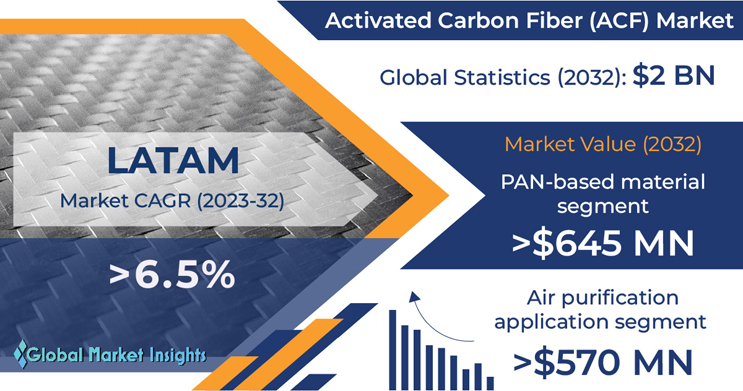Rising Pollution Levels To Offer New Growth Opportunities To The Activated Carbon Fiber Market Share
By Vijay Ovhal

Rapid industrialization pushed by record population growth and urban migration, in tandem with several other factors such as excessive use of nitrogen-based fertilizers and pesticides, forest fires, residues in agriculture, and improper waste management, has deeply intensified pollution and environmental health risks.
However, these concerns have a greater prevalence in low-and-middle-income countries due to lax regulatory framework, but if left unmanaged, these can hinder economic growth in poor and rich countries alike. With over 100 billion tons of raw material entering the global supply chain each year, quoted by a circle economy publication, the need for solutions that can lower the environmental impact caused by the extensive use of resources stands crucial.
Activated carbon fiber, a promising fiber-shaped microporous material with a well-defined porous structure that finds widespread applications in wastewater treatment, pollution absorption, and air purification systems, enters the picture.
Increasing Pollution Levels To Provide New Dimensions To The Activated Carbon Fiber Market
Pollution has emerged as one of the largest environmental causes of premature death and disease over recent decades, with air pollution being one of the most prevalent and fatal. Speaking of the statistics, according to the World Health Organization (WHO):
- The combined consequences of ambient and household air pollution cause an estimated 6.7 million premature deaths annually.
These estimates depict several times more deaths than by tuberculosis, AIDS, and malaria, combined. Global health calamities, such as the COVID-19 pandemic, are reminders of strong connections between human health and the environment and highlight the need to address these links systematically.
To that end, several governments and associated authorities have implemented stringent rules and mandates to contain air pollution and related health damage. For instance, the Clean Air Act, rolled out by the U.S. EPA, works with state, local, and tribal governments, stakeholders, and other federal agencies to reduce air pollution and the harm that it causes.
That being said, with the consistent decline in air quality and the noticeable flare-up in several respiratory disorders across the globe, the need for air filters with high-efficiency particulate air (HEPA) stands crucial. While not much is feasible regarding the outside weather, technology can definitely help keep our indoors clean.

Wastewater Treatment — Creating Endless Possibilities For The Activated Carbon Fiber Market Outlook
- 36% of people worldwide live in water-scarce regions.
- 80% of global wastewater is released into the environment without adequate treatment.
Off late, wastewater treatment is the need of the hour in water-stressed countries and is being viewed as an industrial opportunity to rejuvenate freshwater resources. This can be due to the flourishing textile sector across both developed and developing countries, as textile manufacturing and dyeing facilities are among the largest industrial units releasing a tremendous amount of wastewater containing refractory compounds such as dyes and pigments.
The latest estimations by the National Council of Textile Organizations (NCTO) suggest that the value of man-made fiber, textile, and apparel shipments in the U.S. totaled around $65.2 billion in 2021. This calls for a paradigm shift at multiple levels to promote sustainable sanitation services toward a circular economy that considers wastewater a priceless resource rather than a liability.
Policymakers globally have been analyzing the prospects of using treated wastewater as a replacement for freshwater for industrial processes, irrigation, and recreational purposes. Doing so not only helps maintain environmental flow but also aids the extraction of several byproducts such as energy, clean water, fertilizers, and nutrients and achieves sustainable development goals.
Since activated carbon finds extensive usage in purifying liquids and gases in a multitude of applications, such as municipal drinking water, odor removal, industrial pollution control, etc., efficient investments in wastewater and other sanitation infrastructure will create a favorable outlook for industry growth. Besides, this could further help improve the environment, achieve public health benefits, and enhance the quality of life.
R&D Initiatives To Stimulate Activated Carbon Fiber Market Demand
While many factors have aided the expansion of the activated carbon fiber market, the contribution of new research and development projects focused on developing advanced products cannot be ignored.
To quote an instance, Water2, a UK-based water technology brand, with the support of the University College London (UCL), introduced a new product, the Pod, an under-sink water filter that utilizes silver ionization and activated carbon to filter tap water to up to 0.1 microns. The filtration level is over 1,000 times finer than numerous typical household water jug cartridges.
This apart, the positive outlook of the global chemical industry is yet another factor redefining the industry trends, owing to the widespread use of activated carbon fiber in a range of catalyst carrier applications.
Moreover, the increasing number of cannabis enthusiasts and the subsequent rise in the popularity of smell-proof weed bags, attributed to their ability to conceal the odor of marijuana due to strict mandates regarding product usage, has further boosted the uptake of ACF. All these factors, in tandem, will transform the market dynamics in the foreseeable future.
Source: https://www.gminsights.com/industry-analysis/activated-carbon-fiber-acf-market
